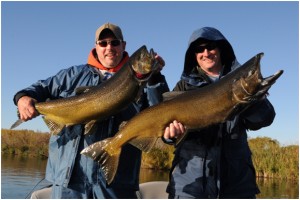Michigan has a plethora of fish species to target, and many anglers only target yellow perch through the ice, choosing to target other species during the warmer months. But yellow perch are a tasty panfish that can be successfully targeted and caught year-round.
Yellow perch are roamers by nature, most often gathering in schools. They can be here one day, and gone the next, having moved on for no apparent reason. They can congregate in huge schools, eating aggressively as they go. A highly adaptable fish, forage for perch can be extremely varied. Seemingly everything is on the proverbial table as far as forage for perch; round gobies, various minnow species, shiners, crayfish, mayflies, wigglers, scuds, freshwater shrimp, worms and more are all fair game for perch. Thus, tactics for catching Michigan’s perch can be extremely varied as well.
Many anglers stick with a typical perch rig with two hooks, either threading live wigglers or minnows onto the hook. This is a tried and true technique, and can often be the ticket to a great day’s catch. Another fantastic option on this perch rig is a piece of cooked shrimp. Some days, the bigger perch really seem to have a preference for wigglers, minnows, or even shrimp. Having all three onboard can pay dividends when the bite gets fussy. The tried and true isn’t always the rule of the day, however, and a variety of other techniques can sometimes lead to an undiscovered bite, or target larger fish.
One such technique is a jigging spoon. Not just a winter-time technique fished through the ice, a jigging spoon can often target the biggest fish in the school. There’s something about the erratic flutter, fall and flash that can really trigger big jumbos to bite. Cast and retrieved in a yo-yo lift-fall manner, perch respond very well to this lure. Also, jigged vertically below the boat when the school is directly below can be another great option with jigging spoons. Jonah Jigs in ½ ounce, ¾ ounce or even 1 ounce are what are most commonly on Sport Fish Michigan’s boats when employing this technique. While jigging spoons are not often the best way to target numbers of fish, they can often trigger the biggest in the school, and even call in roaming packs of jumbos. Similar to the jigging spoon is another option most often employed during the ice season – Rapala’s Jigging Rap. Many lures make similar offerings, but Rapala’s Jigging Rap is probably one of the most prolific fish catchers of all time in this category. That being said, there are many other lures in this category that all catch plenty of fish. Moonshine Lures’ Shiver minnow, the Acme Tackle Hyper-glide, Northland’s Puppet minnow, Custom Jigs & Spins Rotating power minnow, and Lunkerhunt’s Straight up are just some lures in this huge category. These options can be fished vertically or horizontally cast and retrieved and at times can lead to fantastic catches of not only perch, but also walleyes that may happen to be in the area.
While many waters hold impressive perch populations, some waters have a better tendency to grow true jumbo perch stretching 12 inches or better on a regular basis. Lake Erie has been long established as not only a walleye factory, but also great for perch. Lake St. Clair is another big body of water known for outstanding perching. Further to the north, Saginaw Bay is yet another body of water probably better known for its walleye fishing, yet hosts an impressive perch fishery. Further to the north still is the Grand Traverse Bay area. Here, many inland lakes support a prolific fishery for jumbo perch, and the Grand Traverse Bays are in the midst of a major comeback in perch numbers and size. Towards the tip of the lower peninsula lies Burt Lake, another incredible lake for a variety of species with perch certainly amongst them.
Certainly, there is no shortage of spectacular lakes here in Michigan to target yellow perch. From young angler to older angler, they continue to be a crowd pleaser. On the water, and on the ice.





